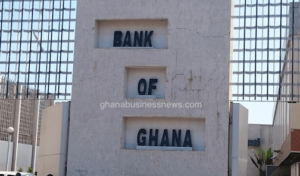Expenditures and arrears clearance balloon Ghana’s public debt to GH¢336b – Bank of Ghana
 Last week the Bank of Ghana Monetary Policy Committee (MPC) issued its report and announced the policy rate, which is always the highlight of the press conference following the MPC meeting. The report points to a ballooning of the country’s debt stock which has increased 76.4 per cent of GDP. Ghana has been described as being at high risk of debt distress.
Last week the Bank of Ghana Monetary Policy Committee (MPC) issued its report and announced the policy rate, which is always the highlight of the press conference following the MPC meeting. The report points to a ballooning of the country’s debt stock which has increased 76.4 per cent of GDP. Ghana has been described as being at high risk of debt distress.
According to the central bank, total expenditures and arrears clearance amounted to GH¢61.1 billion, which is 13.9 per cent of GDP. The figure the Bank says, was below the programmed target of GH¢63.8 billion, pegged at 14.5 per cent of GDP.
“These developments impacted the stock of public debt which increased to 76.4 per cent of GDP (GH¢335.9 billion) at the end of July 2021, compared with 76.0 per cent of GDP (GH¢291.6 billion) at the end of December 2020. Of the total debt stock, domestic debt was GH¢173.4 billion (39.5 per cent of GDP) while the external debt was GH¢162.5 billion (37.0 per cent of GDP),” the Bank said.
The Bank noted that provisional data on the budget execution for the period January to July 2021 indicated an overall broad cash fiscal deficit of 6.1 per cent of GDP, against the target of 5.7 per cent of GDP. “This was due to higher revenue shortfalls,” it explained.
The Bank stated that the corresponding primary balance was a deficit of 1.9 per cent of GDP compared to the target deficit of 1.3 per cent of GDP.
“Over the period, total revenue and grants amounted to GH¢34.3 billion (7.8 per cent of GDP), below the projected GH¢38.8 billion (8.8 per cent of GDP).
However, on the domestic economy, the Bank said developments continue to point to sustained recovery in economic activity following the downturn at the peak of the pandemic.
“The latest data from the Ghana Statistical Service indicates a stronger pick up in the annual GDP growth to 3.9 per cent in the second quarter of 2021, from the 3.1 per cent recorded in the first quarter, and a 5.7 per cent contraction recorded in the same period of 2020. Non-oil GDP, for the same period, grew by 5.2 per cent, compared with a contraction of 5.8 per cent recorded for the same period in 2020,” it said.
It added that the stronger growth performance in the second quarter reflects the sharp rebound experienced in the cocoa sub-sector which grew by 27.6 per cent; supported by equally stronger growth of 18.7 per cent in Hotels & Restaurants, 13.8 per cent in Real Estate, and 10.7 per cent in trade.
“This stronger performance was however, moderated by a contraction of 18.9 per cent in the mining and quarrying sub-sector, on account of a 10.8 per cent contraction in the production of oil and gas,” it said.
By Emmanuel K. Dogbevi
